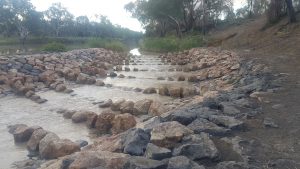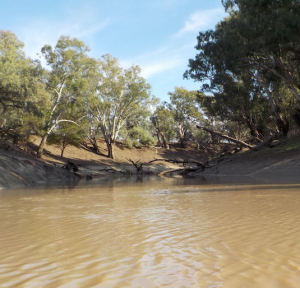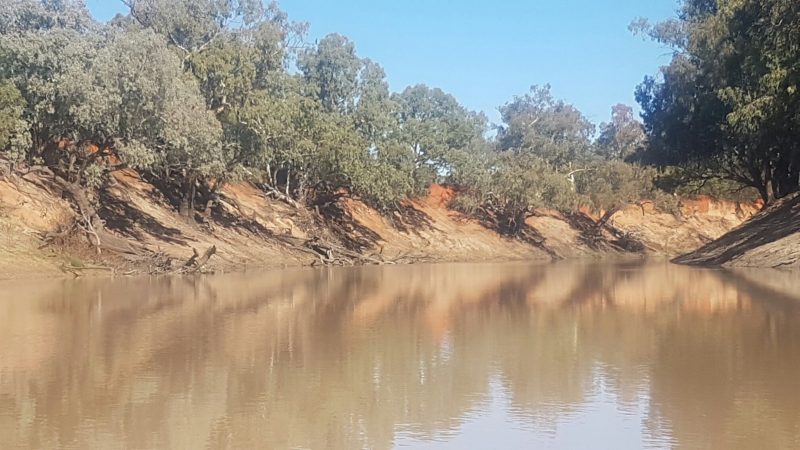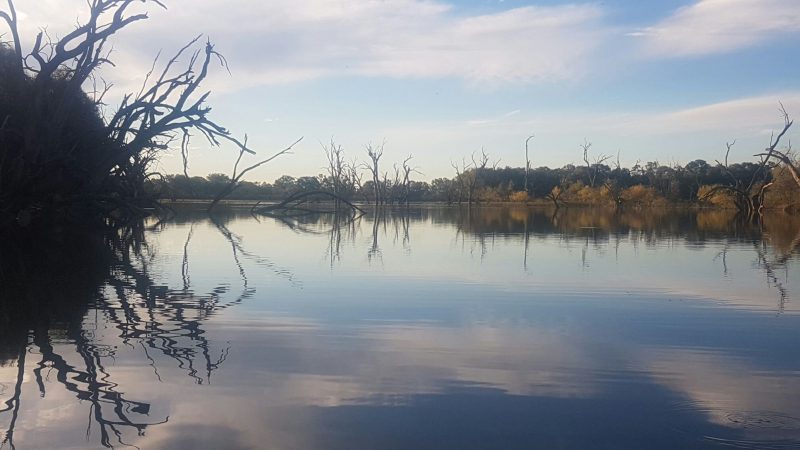While River Darling officially begins about halfway between Brewarrina and Bourke, wanting to travel the entire length of the Darling we started at Brewarrina (“Bree” to the locals). We launched 2kms upstream of the Brewarrina weir and were at first a little confused as there was no discernible current and the initial reach of the river tracked north. Only when we passed under the bridge on the outskirts of town and sighting the Brewarrina weir downstream were we able to confirm we’d got it right.
As always at the beginning of a long trip the boats were overloaded and unwieldy. After months of planning it was hard not to over-cater and include many items of marginal value. This is always at its worst over the first couple of days as the gear carried is whittled down to essentials. Limited training in empty boats doesn’t prepare you for the inertia of one which is fully loaded. The upside is that a fully loaded boat is more stable, even with gear strapped to the decks. In fact you soon learn that often tippy and unstable sea kayaks are at their best when filled with gear.
W. was carrying a bladder filled with fresh water placed under his knees in the cockpit so when water started pooling in the bottom of the boat we assumed the bladder had sprung a leak. After repeatedly bailing, only to see the water quickly replace itself we realised there was a bigger problem. Dark brown water the same colour and opacity as the water in the river continued to flood in. 400 metres down, 1500 odd kilometres to go and the allegedly lightweight but unbreakable, high-tech Prijon marlin sea kayak was leaking like a sieve, not the start we were hoping for after months of planning and three decades of anticipation.

The Darling at Brewarrina is famous for what are said by some to be the most ancient structures built by man – stone fish traps which it is claimed have been in place for over 40,000 years (others claim they were built by Chinese immigrants about 80-100 years ago). The weir at Brewarrina is a wide, all stone construction. The most elaborate and interesting weir on the Barwon/Darling it has recently been rebuilt with large rock slabs to give the impression of being a natural feature of the river. B. and W. chose to walk their boats down the fish ladder running along the eastern bank and were over in a minute while D. with his open, barge-like Hobie boat decided to make a complete portage and wheeled his kayak past the weir on the western bank, landing about 100 metres upstream and launching about 50 metres downstream. There are no formal landing or launching points and access would depend on the level of the river. If the water was a little higher than the approximately 300ML per day flow we experienced at the time it would have been possible to paddle down the fish ladder clear to the downstream exit.

After crossing the weir the river is broken up by several islands of rushes and reeds. The channel on the eastern bank was the deepest and easiest to navigate and once we passed through the short mid-river maze the Darling opened up before us. There were a few people fishing on the river bank, reporting they usually caught yellowbelly. The stretch of the river below the weir appeared to be visited regularly and there was more rubbish and damage to the banks than we would have liked to see. The current ran as strongly as it did anywhere the whole length of the river so soon we left the detritus of civilisation behind and with every bend of the river the riparian world showed fewer sign of human degradation.
There were no obstacles in the river that first day which caused even the slightest inconvenience. Anyone used to kayaking in Australia is also used to portage and grounding. Even though the river was flowing at a relatively low level there was a distinct channel to follow all the way and no danger of bottoming out in shallows except in the reed beds immediately after the Brewarrina weir. This raised our spirits no end as our greatest fear for the adventure was being seeing a dry or impassable riverbed and having to somehow carry our gear from one navigable section to the next. Seeing plenty of water immediately below the Brewarrina weir gave us hope that the rest of the trip would be the same.

While the sense of isolation grew with every bend and reach we realised later this upper section of the Barwon was perhaps the most uninteresting of the whole trip. The riverbank vegetation was dominated by burrs which were impossible to avoid every time we landed. The plants dominated the riverbanks for several hundred kilometres and just brushing against one of the plants was enough to have a dozen burrs attach to your clothing and stick like velcro. Somebody mentioned they had heard somewhere that velcro (invented so the astronauts wouldn’t have to fumble with buttons or zips on their spacesuits) was inspired by the hooked appendages of a burr. Here, just a couple of kilometres from Brewarrina the few grazing feral goats we spotted on the banks were covered in them though for some reason the sheep flocks seemed immune.
Being old, unfit and having spent the previous 3 days driving up and down the length of the river we agreed to an early finish the first day. All along the river our plan was to make the most of the camping opportunities and enjoy the wilderness experience and fish the most remote reaches of the river rather than being obsessed with covering distance every day. We’d met kayakers on other rivers whose main interest was covering distance, but for us the paddling was a means to an end; to get us to an out of the way place where we could settle in and enjoy what River Darling offered in abundance – the silence and sense of isolation.
There were very few good camping sites available in the first 10kms after Brewarrina which is what our research had told us to expect for the whole trip. The little information available suggested the banks of the Darling were high, steep and predominantly covered in mud. We settled on a high flat ridge, about 15 metres above the level of the river with a soft-grained mud bank which made landing and unloading the boats a dirty business. But by now the realisation we were on the great river had struck all three of us and the portage up and down the bank was completed in high spirits, as were the rest of the daily campsite chores.

One of the great luxuries of travelling in remote places where the asymmetrical, broken red gums dominate the banks is the bounty of firewood available. Red gums are notorious for shedding their limbs without apparent warning and this first campsite was surrounded by piles of the long-burning timber, well seasoned from exposure to the dry indigenous climate. When the old, dry logs were lifted or dragged towards camp we noticed there were almost no insects living under the fallen wood. This suited D. who admitted feeling guilty about ever throwing logs into the fire in which termites or ants had made their nests. Sheepishly B. and W. agreed that they had replaced wood they had selected when it proved to be a home for insects, being too soft-hearted to throw them into the fire. Gathering the wood into a pile it took no time for a substantial blaze to take hold and as the darkness fell we watched ol’ Sol slide below the horizon.
When the sun rose W. was down by the river trying to find what where his boat was leaking. Prijon marlin kayaks are vacuum formed from sheets made of a material called “prilite”, a thin, flexible plastic. It was only after half filling the cockpit with water and rocking the boat from side to side that the leak was revealed. Most likely after being damaged during the 1000km odd drive from Brisbane water was pouring from the seam where the top and the hull of the boat joined. D. was carrying a Hobie product called “goop”, a thick, viscous adhesive, similar to silicone. Applied to both sides of the black strip which covered the join and finished with a couple of lengths of duct tape it didn’t leak another drop for the rest of the trip.
Day #2 – 11km – 40km Downstream of Brewarrina
One of the points of interest we passed that day was the junction of the Bokhara river. Unfortunately there was no flow at all at its mouth and as far as we could see it was blocked with jumbled snags which would have made navigation impossible in anything but a flood. We had intended to navigate upstream any of the tributaries we passed but there was no chance of getting anywhere on the Bokhara. It was like most streams in that part of Australia affected by ephemeral flow and irregular rainfall. In the early 20th century work groups employed on government contracts moved up and down many of the rivers clearing the snags and burning them on the riverbanks to make it possible for the paddle steamers to reach remote stations in times of flood or high rainfall. These days the rivers are untouched and it is in fact illegal in most places to remove fallen timber and driftwood from the course of any river so the natural cover preferred by native fish is left in place.

Our spirits were lifted by the sudden improvement in the campsites spotted on the banks. A few beautiful white sand beaches appeared on the bends though at first many of them were actually mixes of light, dried mud and sand so the ground crunched underfoot when we landed to have a better look. The further we travelled down the river towards the next weir the cleaner the sand became. High sand benches near the top of the bank had cleaner sand, those closer to the level of the river were increasingly mixed with mud and soil. In some places the beaches were comprised of fine white sand much like you’d see on a tropical island. We spent a lot of time speculating as to what river were the best for the formation and maintenance of these sandy beaches and after a few weeks of observing the different beach shapes and their different positions on the bends we reached a consensus on where it was most likely the best camping spots would be found. More on that later.
The countryside we passed all day grew better and better so our second night’s campsite was a major improvement on the first. In the few reaches where the banks fell down almost to the level of the river we saw the countryside flattening out and the left bank of the river studded with rocks and broken reef. Flat, soft green grass, trimmed short by grazing animals grew almost to the water’s edge and several large lone-standing red gums provided shade and shelter along with all the firewood we could burn for a week. It was an idyllic scene – something out of a classic bush painting – and once our tents were pitched, firewood dragged into a heap and our mattresses laid-out in the shade where we could watch the river break and burble while it flowed over the shallow reef in front of our campsite, we set the fishing lines for the first time using the classic freshwater native bait – a cube of Bega cheddar cheese.

And there was a bite right away. B.’s short graphite rod was hit almost immediately by a powerful and incautious fish. Tap, tap, tap……. BAAAANG! The drag screamed in an ascending pitch while the rod doubled over. The solid tubular metal rod holder rammed into the dry earth on the bank began to wave and jerk, threatening to take off into the stream as the hook set in the unseen adversary. The fish felt the hook’s sting and set off upstream at a rate which made the eggbeater reel protest more loudly and give out line at the rate of five metres a second. As B. ran to grab the rod and adjust the pressure of the drag his companions found the energy to rise on an elbow, yelling encouragement and advice.
“It’s a monster,” D. called. “Turn its head before it reaches the snag or it’s all over!”
“Don’t let it beat you”, offered W. still lying on his mattress. “Losing the first fish of the trip is a bad omen. If we don’t catch anything else it will be your fault.”
Neither piece of advice diminished B.’s excitement at the power of the strike or the speed of the escapee’s bolt for freedom. The snag his aquatic adversary was speeding towards at a scarcely diminished rate was a wide, fallen redgum trunk which had been washed into place long ago by flood waters and was now cemented with a conglomerate of hardened mud and rounded stones into a permanent feature of the riverbank, extending into the middle of the stream where the concentrated flow of the river backed up against it. It was here the two combatants determined to fight to the last. B. continued to tighten the drag of the small reel to the point we could hear the monofilament sing under tension as the fish cut one way in the water and then another, frustrated by its unseen yoke so that it shook its head just under the surface and broke the water – though not so much that we could determine its type. Slowly the pressure of the drag turned the fish from the snag and it began a long run downstream using the pull of the current to its advantage. It was however a fatal mistake as the open bank and the lack of cover in that direction played heavily in B.’s favour. After several more minutes the fish had tired itself almost completely and after a final futile attempt to zigzag across the current was brought into the shallows before us, passive and glistening, to lie spent on a flat beach of light grey mud. Just a carp, but a big one, almost 9 pounds in the old mark when tested with D.’s scale and it had put up a battle which would shame a cod twice its size. It’s beautiful markings – flashes of bronze and gold with blood-red highlights along with it’s perfect 50 cent piece sizes scales – made us wonder not for the first time at the ability of seemingly barren Australian rivers to hold so much life. B. dispatched the carp with a blow to the head and threw the carcass high on the bank where it could be eaten once we had moved on by one of the many kites and hawks watching from treetops on the adjacent bends of the river.

There was no further fishing action that afternoon and as the sun set, it cast a continually changing pattern of colours over the high clouds which stretched to the horizon. We felt for the first time on the trip we were experiencing what we’d hoped to find on this distant, silent river. Not a single mosquito, moth, midge or other unwelcomed insect bothered us as we sat around the fire that night, building a pile of crackling red gum boughs which burned bright and clear long after we had all fallen asleep by the fire.
Day #3: 40km – 75km Downstream of Brewarrina
It was cold when we woke the next morning. The boats were covered in frost and the few cans of medicinal coca-cola in our supplies left in the open overnight were as cold as any served at an outback pub. There were still live coals from the previous night’s fire but we doused them and ate muesli rather than a cooked breakfast.
We prefer to set our own individual pace on the river when travelling long distances so each of us leaves at the time and paddles at the rate which suits. No doubt some experts will find fault in this but it gives us plenty to talk about at night around the fire and we never tire of each others’ company. Many times we’ve been asked during trips why we don’t paddle tandem kayaks. It would be difficult for small disagreements not to inflate spending so much time a few feet from each other on so long a trip. So that morning B. and W. set off at much the same time and D. launched an hour later. This was the pattern over most days.
The river through this section meandered more than it had the two previous days and we began to feel the sense of isolation most visitors to the Darling remark upon. The river was open and easy to travel most of the way with only two large snags, both of which had gaps wide enough to allow small power boats through so we had no problems in the kayaks. It was impossible to tell the depth of the river at any point other than the few gravel races or minor rapids. While the water was so cloudy if you put your hand a centimetre underwater you couldn’t see it but bottoming out was rare other than in the few shallow races we saw where the water hurried ahead for a moment at the end of long pools of still water.
During the day we all saw black cockatoos, which everyone will tell you are a sign of coming rain (it rained once for half an hour on the whole trip). Yackinruckin Creek joins the Darling at the 65km point but it was completely dry and again filled with snags. We all spotted a lost goat kid bleating pitifully by the waterline. A local farmer told us further down the river that the female goats are not particularly good parents and many of their offspring are lost.

At a long semi-circular bend, the 72km mark on our maps, we spotted what had been the best potential camping site we’d seen so far on the river. On the point of a steep bend in the river was a high white sand bank which glistened brightly in the sun. We were tempted to stop but because we were already behind on our schedule (B. had only a 2 weeks break from work and had to finish at Louth) and had only a single spare day to play with we agreed to set a minimum of 35km objective every day. Luckily enough the first major bend after the 75km mark also held a beautiful sandy beach. We settled for the night and for the first time set the shrimp pot, using cheese as bait. While we caught a few small shrimp we didn’t get a bite on the lines.
Round the fire that night we began reading aloud a classic Zane Gray short story – “Down an Unknown Jungle River” part of a collection of his famous fishing tales titled “Tales of Southern Rivers”. A rip-roaring tale of Zane and his companions’ death defying navigation in a skiff of a wild Mexican river. And I apologise to the estate of the great man for the clumsy imitation of his literary style featured in places on this blog.
Day #4: 76km – 115km Downstream of Brewarrina
Through this section the river becomes more winding and intimate. Large piles (rafts) of driftwood had accumulated on many of the snags and good quality campsites could be seen on most bends. There was a lot more birdlife than we had seen upstream including several flocks of pelicans and black cormorants. Most reaches of the river held heron, darter and egrets and on two occasions we spotted sea eagles. Always wary, they never let us close enough to take a good picture or look at them carefully. They are a muscular, broad chested raptor with a relatively short wingspan. We also spotted three injured pelicans which were unable to fly though each of them seemed to be in good condition. One had an open wound to its neck and looked like it had been attacked by a fox. Piles of scattered feathers on several bends also pointed to the possibility that reynard (foxes) were predating the pelicans while they roosted at night.
We covered 40kms that day and made it to the junction with the Bogan River. Again the Bogan was dry and its mouth clogged with snags. We camped on a sandy bend, W. and B. arriving at camp around 3.00 in the afternoon. We didn’t catch any fish again that night and all went to bed early after what had been a fairly hard day with four consecutive days of paddling catching up with us. It was cold again at night – down to 3 degrees.

Day #5: 115km – 155km Downstream of Brewarrina
River Culgoa joins the Barwon at the 122km mark to officially form the Darling. We were able to paddle a few hundred metres up the Culgoa but it quickly petered out into a muddy channel marked only by goat and cattle tracks. After its junction with the Culgoa the river meandered more than it had upstream though there was no other apparent change to its appearance. There were plenty of good sandy beaches which would have made ideal campsites and most bends had a beach.
W. had brought his compound bow, Justice, and for the first time we spotted feral pigs. There were three of them, two black and one with a piebald/brindle pattern. W. paddled past the three which were standing on the edge of the river and seemed to take no notice though he passed within 15 metres, the perfect (theoretical) distance for a kill shot. Landing his boat a hundred metres downstream W. went through the routine of knocking an arrow and stalking along the top of the bank but once he was on land the swine took a very different view of his activities and immediately leapt into the river and swam quickly to the other side. When they emerged they were out of range so any shot would have been more likely to wound than kill. The pigs hightailed it to the top of the bank and kept running till they were out of sight.
Day #6: 155km – Burke (205km downstream of Brewarrina)

The river through this section is comprised of long reaches and the water is slow moving as it backs up from the Burke weir. The banks were different to anything we’d seen upstream with a number of rocky shelves marking the edges of the river. With the deeper water there were a lot of fishing birds, large flocks of cormorants and pelicans were spooked every time we rounded a bend. We saw half a dozen wedgetail eagles which watched us cautiously and flew from tree to tree as as we approached, always keeping tree boughs between them and us so it was difficult to get a close look. A lot of emu and goats were spotted, including a small white goat which had climbed a tree and walked backwards and forwards along a branch overhanging the river, bleating at us as we passed.
The paddle steamer Jandra was plying the weir pool and gave us a blast of the steam whistle as it went past. This was a sign we were only a few kilometres from arriving in Burke. For the first time on the trip it began to rain and by the time W. arrived first at the Burke wharf it was coming down steadily.




